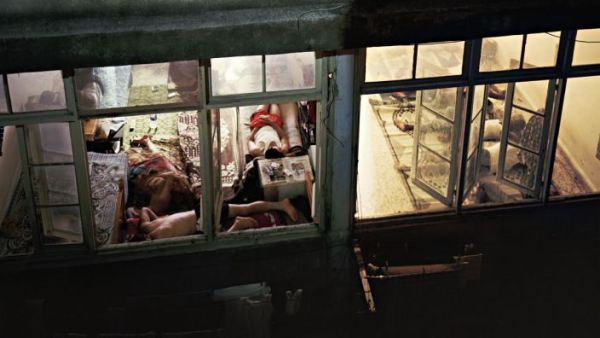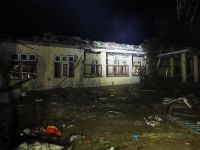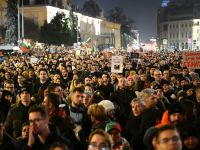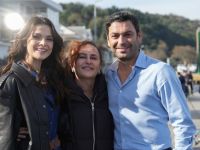Just before dawn, a lone cameraman assembles his equipment in the aperture of an open window. As the sun begins to creep over the horizon, he takes a series of slow exposures, capturing the stained wall of a concrete building, perforated by two large windows. Behind these windows a group of men – oblivious to his unseen presence – are sunk deep in sleep on sofas, beds and on the stone floor.
The scanty light means the photographer must leave the shutter open for long periods, capturing not only the sleeping figures but their motions. Some, who lie as still as the dead, are in perfect focus. Others appear a blur as they twist and turn fitfully.
The photographer is Lebanese artist George Awde. The photographs are part of a series entitled “Windows,” part of the collective exhibition “Another Time” currently on show at Karantina’s Running Horse Contemporary Art Space.
Awde’s photographs – taken in, through or beside windows – are accompanied by a single installation piece by Paris-educated Lebanese artist Stephanie Saadé.
Entitled “Window Shade,” Saadé’s installation is a venetian blind, tailor-made to fit the vertical space of the gallery’s large front window. A photograph is printed on each side. The first is a daytime sky, the deep blue of dawn or dusk, imbued with a rosy glow. The second is an image taken at night, a sheet of impenetrable black.
It is the third time the two artists have taken part in the same exhibition, although they emphasize that they hardly know one another. Running Horse curator Lea Sednaoui, who brought the two together in last year’s collective show, “A Territory of Resistance,” reprised the pairing for “Another Time,” which echoes similar themes. Although the artists work independently, their pieces are united by a common preoccupation with temporality and their exploration of windows both as entry points and barriers.
“[‘Window Shade’] is linked to the ‘A Territory of Resistance’ pieces because it’s a photograph,” says Saadé. “I [often] make use of photographs as a material. I am not interested in photography itself – I would never exhibit a photograph framed, for example. I use it the same way I use wood or metal. ... Even if the aspect of these pieces is different, it’s the same material, so I consider that it’s the same aesthetics.
“It’s a way of proclaiming every day when the day starts and when the night falls,” she continues, “of marking the time that is delayed, compared to real time. It is linked to the pieces I’ve done before at the gallery in the way that it [erects] a barrier. ... This one creates a secluded space in the gallery, because it’s as if the gallery doesn’t follow the natural cycles anymore.”
In keeping with this concept, the blind is rotated each morning and evening by the gallery staff, so that during opening hours the nighttime photograph faces the outside world, and at night the daytime image is visible from the street.
Awde’s works are a direct continuation from the series he exhibited last year, “Shifting Grounds.” As in his previous work, the photographs are intimate portraits of Lebanese and Syrian men, captured at particularly vulnerable times, while sleeping, semiclad or nude.
“This intimacy is something that’s very important in my work,” explains Awde. “This play between public spaces and private spaces, the way that we enact ourselves and our masculinity, our relationships to each other. ... The moment that I realized that this was its own series was when I took those two photographs of my neighbors sleeping – the ones that I kind of stole.”
The two pictures in question were taken from Awde’s flat, which overlooks the men’s sleeping quarters. Taken through windows, they are a potent mixture of intimacy and voyeurism, at once including the viewer in a private moment and distancing them by virtue of the intervening pane of glass.
The other photos in the series, by contrast, were taken inside the subjects’ bedrooms.
“I’m intimate with these men,” says Awde. “I know them well. My favorite thing to do is to ask them for a key and let them know that I’ll be coming in one day this week. I come in when it’s dark and ... I set up my equipment. I wait for the sun to start to creep up, and they’re still asleep, and I just keep shooting until they wake up.”
Awde tries to balance the different color temperatures generated by the incandescent tungsten bulbs of streetlights and the natural light of the rising sun. Initially stronger, the light from the street lamps becomes perfectly in tune with that of the sun for a few brief minutes, he says, after which the sunlight drowns out the artificial source.
Currently studying in Cairo on a Fulbright scholarship, Awde works with large format negatives. He often shoots for months or even a year at a stretch before developing any of the photographs. His practice is an act of faith.
“There’s this sense of anxiety,” he admits. “Sometimes I have no idea what I’m doing and I’m really nervous that it’s really not working. ... Sometimes I shoot polaroids of key photographs, just to guide me and allow me to see what’s happening, and the most important thing is I take a lot of notes just to stay engaged with what I’ve done and where I’m going with the work.
“One of my responses to [this] is that the projects are never really done,” he continues. “I kind of think of it as a similar process to writing a novel. I don’t like my work to be project oriented – I really am concerned with ideas. ... I’m interested in male bonding, the male body, issues of identity – national identity, citizenship – and I’m always looking for different ways to tell the story of these people that are just trying to find their place.”
“Another Time” is up at the Running Horse Contemporary Art Space in Karantina until June 12. For more information please call 01-562-778 or visit www.therunninghorseart.com.
By India Stoughton








